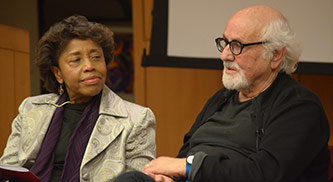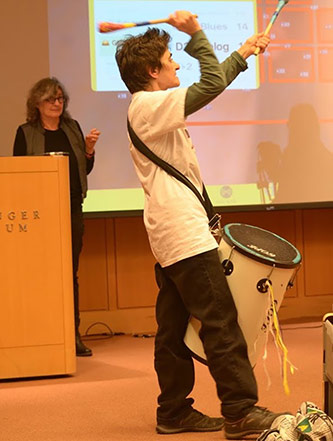American Music Review
Vol. XLVII, Issue 1, Fall 2017
By David Grubbs, Brooklyn College
Almost exactly one year after her passing, musicians, scholars, artists, and writers of all stripes—a multitude of modes on this occasion often entwined within a single individual—came together to pay tribute to Pauline Oliveros in a two-day symposium hosted by Brooklyn College. Douglas Geers, lead organizer of the event, remarked that it was fundamental that Oliveros’s legacy be rendered as the plural “legacies,” and one could imagine that if such a gathering were a person’s first encounter with her work that the breadth of practices and the range of individuals touched—shaped—by Oliveros’s example could be thrillingly vast. Indeed, even people who were close to Pauline—she really was a first-name kind of soul: Hi, I’m Pauline!—or conversant with her work were bound to have encountered some facet with which they were unfamiliar.
The presentations included a trio of papers from Jules Gimbrone, Kristin Norderval, and Mairead Case discussing Oliveros as a trailblazing queer artist (Case’s talk had to do with Pauline’s lifelong veneration for Buck Rogers’ sidekick Wilma Deering); Miya Masaoka on the vagina as the third ear; Mike Bullock on Pauline as a teacher; Ethan Hayden and Viv Corringham on approaches to performing Heart of Tones; and the contributions by Sarah Weaver and Adam Tinkle that are included in the present issue of the American Music Review. Nicholas DeMaison, IONE, Ross Karre, and Monica Duncan detailed the process of staging IONE’s and Oliveros’s opera The Nubian Word for Flowers, which premiered less than a month after the symposium, and a panel including IONE, composers Tania León and Morton Subotnick, and Tony Martin—former Visual Director of the San Francisco Tape Music Center—provided the occasion for spontaneous reflections from kindred artists who had been witness to the growth and changes in Oliveros’s practice over a span of decades.
Perhaps the most surprising of presentations was Leaf Miller’s and Sherrie Tucker’s workshop that described Oliveros’s role in developing the AUMI music system for helping the severely disabled to play music. In their recounting, not only did Oliveros take a lead role creatively in helping to design interactive musical instruments for people who otherwise would not be able to play music, but she also, true to form, convened a multi-city reading group in disabilities studies via Skype, for which she often volunteered to take minutes. Their presentation concluded with a lengthy improvisation that was open to all, and in many ways crystallized the generosity and exploratory spirit common to nearly all of Pauline’s endeavors.
Musical performances spread over two evenings bookended the event. Among the most revelatory were Kristin Norderval’s Listening for Pauline for voice and electronics, Seth Cluett’s mysterious performance of Oliveros’s The Witness (as a duo for an imagined partner), actual duo performances by Fred Lonberg-Holm and Tomeka Reid and by Monique Buzzarté and Sarah Cahill, and longtime Oliveros collaborator Anne Bourne’s pairing of cello and voice on Horse Sings from Cloud. The second concert was capped by a processional performance of Bonn Feier led by Douglas Cohen.
One theme that was echoed in conversations throughout these two days was that Pauline Oliveros’s legacies seem uniquely living. In contrast to numerous other composers, her passing appears less inflected by the problems of preserving her work than it is by reflection on the ways in which her efforts are generatively embodied by those whose lives intersected with hers.









